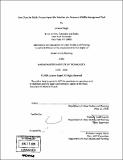| dc.contributor.advisor | Judith Layzer. | en_US |
| dc.contributor.author | Siegel, Julianne (Julianne Susan) | en_US |
| dc.contributor.other | Massachusetts Institute of Technology. Dept. of Urban Studies and Planning. | en_US |
| dc.date.accessioned | 2009-01-30T16:34:14Z | |
| dc.date.available | 2009-01-30T16:34:14Z | |
| dc.date.copyright | 2008 | en_US |
| dc.date.issued | 2008 | en_US |
| dc.identifier.uri | http://hdl.handle.net/1721.1/44336 | |
| dc.description | Thesis (M.C.P.)--Massachusetts Institute of Technology, Dept. of Urban Studies and Planning, 2008. | en_US |
| dc.description | Includes bibliographical references (p. 51-56). | en_US |
| dc.description.abstract | Since the 1950s the human relationship with wildlife in the United States shifted dramatically; from primarily consumptive to primarily recreational. Over the same time period a trend of humans moving into suburban communities further from the urban core developed. These people inadvertently enhanced their new suburban environment to be more appealing to certain generalist species known as nuisance wildlife. Policy decisions for nuisance wildlife species are made at a national or state level; however, municipalities manage most nuisance wildlife-human conflicts. An individual town or city is responsible for controlling populations of nuisance species both financially and tactically. Given that a municipality must select a wildlife management tactic when conflict occurs, do different decision-making processes yield different outcomes? This study identifies the link between public process and management outcomes; a connection that informs municipalities of the decision-making methods that lead to the most effective wildlife management.Through an examination of resident Canada goose management in four small Massachusetts cities and towns this study demonstrates the processes used to select nuisance wildlife management plans and the success or failure of those plans. Through the trials of the municipalities examined, it is clear that management plans selected in the most straightforward and transparent manner, and those that engage the public experienced the greatest success. I contend that open decision-making significantly reduced the risk of public conflict or controversy, and ensured the longevity of the selected management plan. | en_US |
| dc.description.statementofresponsibility | by Julianne Siegel. | en_US |
| dc.format.extent | 56 p. | en_US |
| dc.language.iso | eng | en_US |
| dc.publisher | Massachusetts Institute of Technology | en_US |
| dc.rights | M.I.T. theses are protected by
copyright. They may be viewed from this source for any purpose, but
reproduction or distribution in any format is prohibited without written
permission. See provided URL for inquiries about permission. | en_US |
| dc.rights.uri | http://dspace.mit.edu/handle/1721.1/7582 | en_US |
| dc.subject | Urban Studies and Planning. | en_US |
| dc.title | How does the public process impact the selection of a nuisance wildlife management plan? | en_US |
| dc.type | Thesis | en_US |
| dc.description.degree | M.C.P. | en_US |
| dc.contributor.department | Massachusetts Institute of Technology. Department of Urban Studies and Planning | |
| dc.identifier.oclc | 276305485 | en_US |
